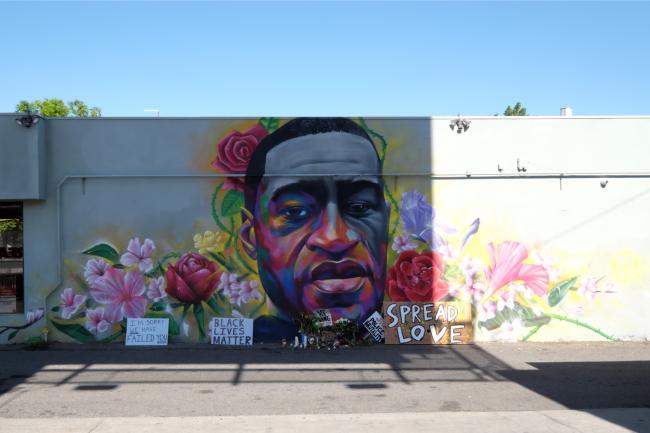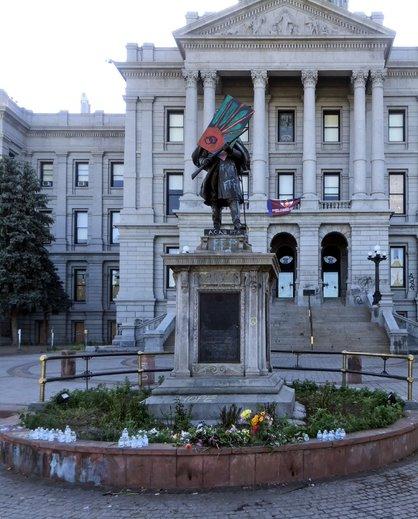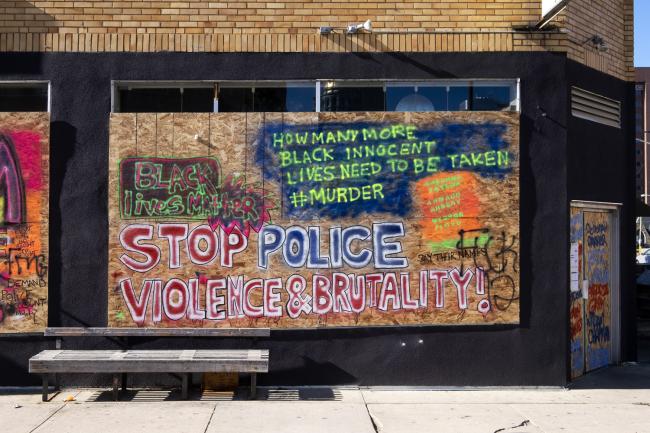Banner image by Jonathan Moller
By: Marina Nye, Curatorial Research Assistant and PhD Student, UCLA History dept.
Contributors to the Collecting Community History Initiative (CCHI) captured powerful images of the Black Lives Matter protests. Some of the photographs captured messages of resistance that were inscribed across public spaces such as buildings, storefronts, sidewalks, vehicles, and statues. Whether these messages were written hastily with spray paint or took hours of careful precision, they all express the importance and gravity of the movement. These messages are public displays of resistance that force Americans to confront systematic racism in the United States.
As store fronts boarded up their shops in hopes to deter looting, protestors wrote short phrases on these empty plywood canvases. Contributor Jonathan Moller shared a photo of a storefront in Denver, Colorado with boarded up windows and doors. In the image, the once bare plywood boards are covered with vibrant colored words that say, “How many more black innocent lives need to be taken #murder” and “Stop Police Violence & Brutality.” Another image Moller shared captures the front of the Colorado Education Association building. Under the building’s sign is a large mural painted onto plywood. In red, white, and black, the mural states “Education and Thrive,” “Black Lives Matter,” and “Stay Together.” Accompanying these phrases are images of Breona Taylor and George Floyd.
Some messages inscribed on storefronts were quickly graffitied rather than slowly crafted. Madison Tea’s photograph shows an empty storefront in Los Angeles, California covered in hastily written messages. Under the store sign “Harper,” graffiti in various colors cover the glass windows next to a “for lease” sign. Some of the words include “ACAB” and “George Floyd.”
Buildings were not the only public spaces covered in protest messages. Ricardo Maenco submitted a photograph of multiple protesters on top of a Los Angeles Metro bus which was covered in graffiti. The bumper has the message “Value-Hueman-Race” written in spray paint. The CCHI archive has multiple submissions where messages of resistance are expressed on vehicles such as buses and police cars.
Statues became a particular target for written expression. Moller submitted a photo of the Colorado state Capitol Building and the statue in front which memorialized the 1st Colorado Cavalry who died during the Civil War. The statue is covered in protest graffiti with phrases like “FTP,” “ACAB,” “Hope,” and a peace symbol. The statue's face is obscured with a painting of a red sun in the same color scheme as the Pan-African flag. The statue was torn down shortly after Moller took the photo.
While paint covered buildings and objects, chalk was the medium of choice for messages written on sidewalks. Asha Monte submitted photos of protest messages inscribed on the sidewalk with the phrases: “Justice does not come in the form of cops” and “cops aren’t supposed to kill guilty people either.” Protestors of all ages demonstrated their support of the Black Lives Matter movement through sidewalk messages.
Whether written in spray paint or chalk, the messages force the public to confront racial injustice through written expressions of resistance. Photographers at the protests captured incredible artwork and messages on buildings, storefronts, vehicles, statues, the street, and other public spaces. The contributions to the CCHI provide a snapshot of this revolution and the importance of art and words in conveying the movement.
Below is just a snapshot of the submissions to CCHI which demonstrate the power of words.








